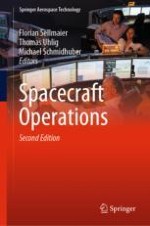2022 | OriginalPaper | Chapter
14. Attitude Dynamics
Authors : Jacobus Herman, Ralph Kahle, Sofya Spiridonova
Published in: Spacecraft Operations
Publisher: Springer International Publishing
Activate our intelligent search to find suitable subject content or patents.
Select sections of text to find matching patents with Artificial Intelligence. powered by
Select sections of text to find additional relevant content using AI-assisted search. powered by
